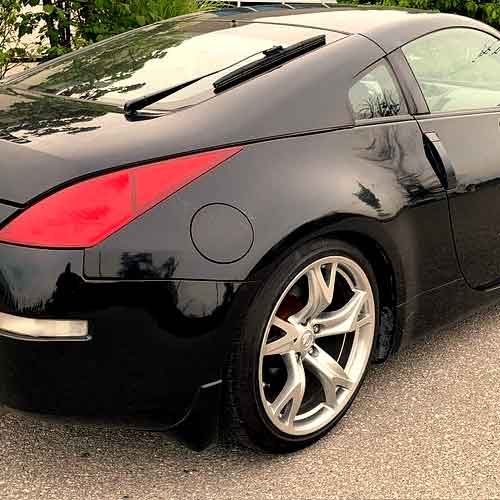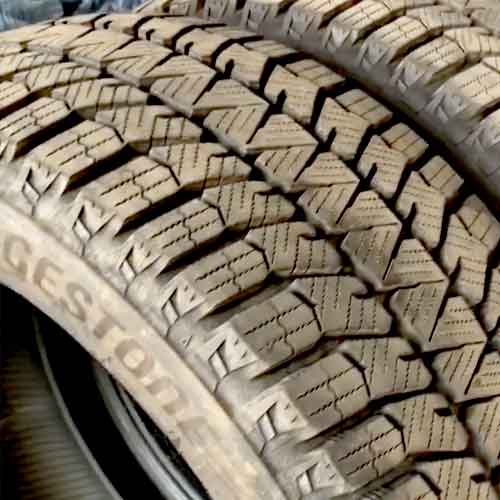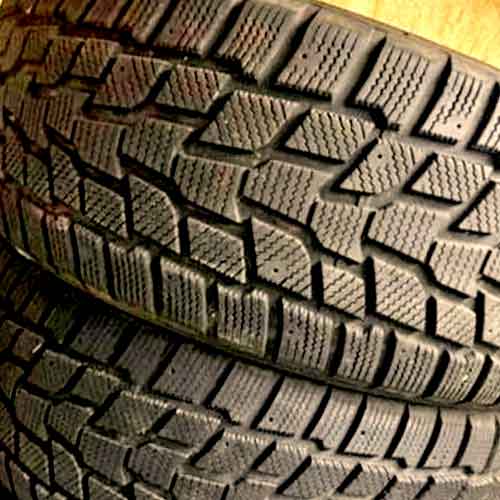The stage is set for Cooper Evolution Winter, boasting its remarkable durability in severe conditions, to clash with the Bridgestone Blizzak WS90, celebrated for its comprehensive winter performance. When these tire titans vie for supremacy, who will claim victory?

Table of Contents
Available Sizes
The Cooper Evolution Winter comes in 67 sizes in 14 to 20 inches, having following specs.
- Speed ratings: T and H.
- Load ratings: SL or XL.
- Tread depth: 12 and 14/32″.
- Weight: 17 to 37 lbs.
- Tread warranty: None.
On the other hand, the Bridgestone Blizzak WS90 offer 52 total sizes in 15 to 19 inches (wheels) with following specs.
- Speed ratings: T or H.
- Load ratings: SL or XL.
- Tread depth: 11 or 12/32″.
- Weight: 17 to 29 lbs.
Review this tire in greater detail: https://snowytires.com/bridgestone-blizzak-ws90-review/
Tread Appearance
The Bridgestone Blizzak WS90 is a robust winter tire showcasing a well-thought-out tread design. Let’s take a deeper dive into its notable characteristics.

So its tread has 3 parts, where there are 2 outer ribs, and the one in the middle.
Starting with the outer ones, the shoulders, you see a lot of biters there.
There are full depth notches facing the middle, laterally, and then there are similar biters arranged longitudinally, (in the central part of these shoulders).
Moreover, you also see zigzag slits, further out.
And yes, of course, there’s a lot of siping here, as one would expect.
The middle rib is made continuous.
And there are lateral slits here, which meet up with the V shaped notches, facing both sides (laterally).
On the other hand, Cooper Evolution Winter also features a directional pattern.

When we look at the tread, we see it has three ribs, in the middle, which are like columns of blocks, if you will.
These “columns” create 4 circumferential channels of very zigzag shapes.
The middle most rib houses arrow-shaped lugs with keen edges, embedded with wave-like sipes that run laterally.
While on the surrounding ribs, you see two types of lugs having multi-angles siping, along with stud holes.
Moreover, these blocks are also “open”, forming wider surrounding grooves, or tread voids.
As for the shoulder lugs, they closely mirror the aforementioned features, including snow vices, sipes, and stud holes.
And yes like the following rib, these blocks also create snow-vices along with sharp (multiple) edges.
Wet Traction
Wet traction is predominantly determined by two elements: tread design and rubber compound. These, in turn, dictate the tire’s grip and hydroplaning resistance. Let’s check them out one by one.
Wet Grip
Despite both tires being equipped with considerable siping and pliable tread rubber, the Bridgestone Blizzak WS90 still gains the upper hand in terms of grip.
This is because, the tire features dual siping design, where you get to see a comprehensive array of rectilinear and interlocking pattern of those slits.
For folks who don’t know sipes work by sucking in water particles, so the biters can grip on the slightly dried up surface, and here dual siping designs work better.
Moreover, as already mentioned in the Ice Performance section, you get multiple angles to siping here on Blizzak too, and so they offer superior biting efficacy on the wet ground.
In contrast, the Cooper Evolution Winter, featuring only laterally oriented sipes, isn’t as proficient in delivering overall traction, resulting in longer wet braking distances and handling times on average.
Hydroplaning resistance
Hydroplaning occurs when water doesn’t let the tread to properly contact the surface below, and so this causes the tire to float a little bit, where all sort of traction is lost. So it’s a big deal.
And out of both tires, the Cooper Evolution Winter performs exceptionally well.
Its broader grooves and sweeping arms, enable higher average float speeds, in both curved and straight aquaplaning tests.
Moreover, its interconnected web of grooves proficiently disperses water in all directions, offering superior hydroplaning resistance overall.
On the other side, the Blizzak WS90 lacks with its longitudinal rib, which doesn’t allow proper sideways removal of water (as quickly as its counterpart).
Dry Traction
Dry traction is two parts, there’s directional grip and then there’s handling. Let’s check out both one by one.
Directional Grip
So dry grip depends on the central area of the tread, as that forms the most contact with the ground, especially when it comes to winter tires, with the rounded contact patch and directional design (for the most part).
And so in this case, with Bridgestone Blizzak WS90 takes the cake.
The tire features a continuous running central most rib, which doesn’t allow for any breaking of the connection between the rubber and the road.
This results in superior baking distances (measure of directional grip).
On the other side, Evolution Winter lacks with it’s wider tread voids, which can’t offer the similar contact patch.
Handling
The overall sideways traction or cornering abilities of a tire hinges on its shoulder lugs.
And here, two things are judged. One, how well those lugs meet with the ground as the tire turns. And two, how much lugs bend, during.
And in both of these aspects, you get to see, the Blizzak WS90 has the upper hand.
It’s closed up pattern forms a greater contact with the ground, and with it’s lighter weight, its lugs don’t want to flex/mold too much as the tire corners.
You see, during cornering, most of the tire’s weight goes towards shoulders, and their bending limits the over and under steering balance, causing a delayed steering response.
That’s why with heavier structures and wider grooves, you see longer handling lap times on Cooper Evolution Winter.
Snow Performance
When it comes to performance on fluffy snow, both tires make a commendable show of themselves, but the Cooper Evolution Winter still inches forward a little bit. And an examination of its tread design shows the reasons behind this.
As already discussed, the tire comes with a greater number of voids, predominantly formed by in-groove notches, which basically serve to entrap snow particles, facilitating better snow-to-snow contact.
The entrapped snow forms the contact patch with the ground as the tire rotates, creating improved traction, and this happens because snow adheres more effectively to itself than to rubber.
Furthermore, the tire features sweeping V-shaped lugs, which are proficient at displacing heavy snow, and aiding forward progression, by pushing the snow backward during rotation. (Newtons Third Law if you will).
And so this attributes contributes to the tire’s slightly superior acceleration times.
In contrast, the Bridgestone Blizzak WS90 takes the back seat here.
And the tire’s longer braking distance and handling times (on tests), are because of it’s rather more sealed/crowded up tread pattern with narrower in-groove notches.
These aren’t able to offer as much snow to snow contact.
Moreover, with missing swooping lugs, you also don’t get the plowing effect here too.
Tread Life
Tread life is highly influenced by rolling resistance, which is the product of tire’s weight and rubber composition.
So it makes sense why the Cooper Evolution Winter takes the back seat in this department too.
The tire’s heavier weight places a lot more stress on the tread, and as lugs are more spaced apart, each lug get to bear more weight pressure upon itself, as they rub against the road with greater force.
And yes, the tire’s relatively softer rubber compound isn’t helping that either.
In this context, the Blizzak WS90 holds the advantage of being lighter, and featuring streamlined lugs, which face smaller friction as the tread meets the road.
Ice Performance
On icy terrain, the situation flips, with the Bridgestone Blizzak WS90 providing shorter braking distance (on average, on all tests). And you also get to see similar results in the acceleration department.
That’s because the tire features a ton of biters spread across the tread.
Its central rib for example gets to have two slanted incisions of varying widths, creating off-set edges, and even those join further into V shaped notches facing in both directions (sideways).
All of these tread features basically better grip on the packed up snow and icy terrain.
And yes, same goes for the sipes. Although both tires have plenty, the Blizzak WS90 gets to provide more angles to them.
In terms of handling, where shoulders play a major role, you get to see a ton of biters there as well.
Like I mentioned in the tire’s tread section, those shoulder blocks get both laterally and longitudinally arranged notches, which grip in all directions.
Moreover, you also get similar to the middle, multi-angled sipes. So these get to be parallel to the direction of tire’s travel, providing extra gripping.
In contrast, the Cooper Evolution Winter, with its wider tread voids, fails to grip the ice as effectively. Also, the absence of notches and multi-angled siping on its central and shoulder lugs leads to a longer average braking distance and handling time.
Though subjectively, its steering feedback aligns closely with that of the Blizzak WS90.
Comfort Levels
Tire comfort is predominantly influenced by factors like road noise and vibration absorption. These factors are determined by the tire’s construction, materials utilized, tread pattern, and sidewall design, which essentially reflects the smoothness during cornering.
Let me start with noise.
So simply put, noise is just air particles hitting the tread walls, so voided the tire gets, the louder it becomes.
That’s why with a smaller tread voids, you see Blizzak WS90 taking the lead here.
Though in the other part of comfort, which has to do with bumps absorption, you see Cooper Evolution performing better.
This is because the tire basically has a relatively softer tread compound, and so the shocks get absorbed in its tread in a much better way.
Fuel Economy
The fuel efficiency of tires is intrinsically tied to their traction and structural weight, and both of which are dimensions where the Cooper Evolution Winter could see some improvements.
The tire has a combination of relatively greater weight and tread voids, and both of these cause extra lug bending, as the tire corners, brakes or accelerates.
This molding/bending of the lugs, of course, causes extra energy expenditure.
On the other side, the Blizzak WS90 has a more streamlined, longitudinally aligned ribs, which don’t produce as much of the rolling resistance.
And the tread compactness, don’t waste energy in to flexing the blocks, and instead focuses that energy in to rolling the tire as a whole.
To Conclude
In terms of snow performance, the Cooper Evolution Winter excels with its unique tread design and larger number of tread voids, showcasing superior snow grip and removal abilities.
However, when faced with icy conditions, the Bridgestone Blizzak WS90 outperforms its rival. It owes this performance to its intricate biters, slanted incisions, and multi-angled sipes, which together enhance traction and handling capabilities.
In a similar manner, the tire also demonstrates superior grip, in both wet and dry roads, though the Cooper Evolution Winter shines in its resistance to hydroplaning.
But when considering all aspects, the Blizzak WS90 edges ahead, given its slightly superior fuel economy, tread life, and quieter performance.